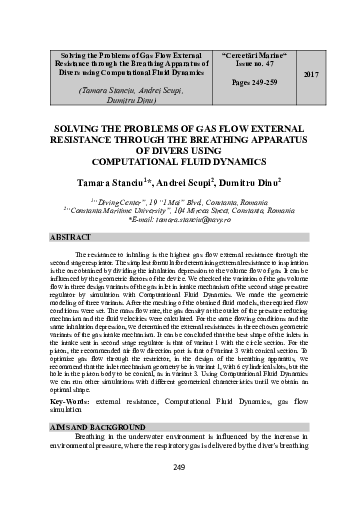Solving the Problems of Gas Flow External Resistance through the Breathing Apparatus of Divers using Computational Fluid Dynamics
DOI:
https://doi.org/10.55268/CM.2017.47.249Keywords:
external resistance, Computational Fluid Dynamics, gas flowSimulationAbstract
The resistance to inhaling is the highest gas flow external resistance through the second stage respirator. The simplest formula for determining external resistance to inspiration is the one obtained by dividing the inhalation depression to the volume flow of gas. It can be influenced by the geometric factors of the device. We checked the variation of the gas volume flow in three design variants of the gas inlet in intake mechanism of the second stage pressure regulator by simulation with Computational Fluid Dynamics. We made the geometric modeling of three variants. After the meshing of the obtained fluid models, the required flow conditions were set. The mass flow rate, the gas density at the outlet of the pressure reducing mechanism and the fluid velocities were calculated. For the same flowing conditions and the same inhalation depression, we determined the external resistances in three chosen geometric variants of the gas intake mechanism. It can be concluded that the best shape of the inlets in the intake seat in second stage regulator is that of variant 1 with the circle section. For the piston, the recommended air flow direction port is that of variant 3 with conical section. To optimize gas flow through the restrictor, in the design of the breathing apparatus, we recommend that the inlet mechanism geometry be in variant 1, with 6 cylindrical slots, but the hole in the piston body to be conical, as in variant 3. Using Computational Fluid Dynamics we can run other simulations with different geometrical characteristics until we obtain an optimal shape.
Downloads
Published
How to Cite
Issue
Section
License
This is an open access journal, which means that all content is freely available without charge to the user or his/her institution. Users are allowed to read, download, copy, distribute, print, search, or link to the full texts of the articles, or use them for any other lawful purpose, without asking prior permission from the publisher or the author. This is in accordance with the BOAI definition of open access.





